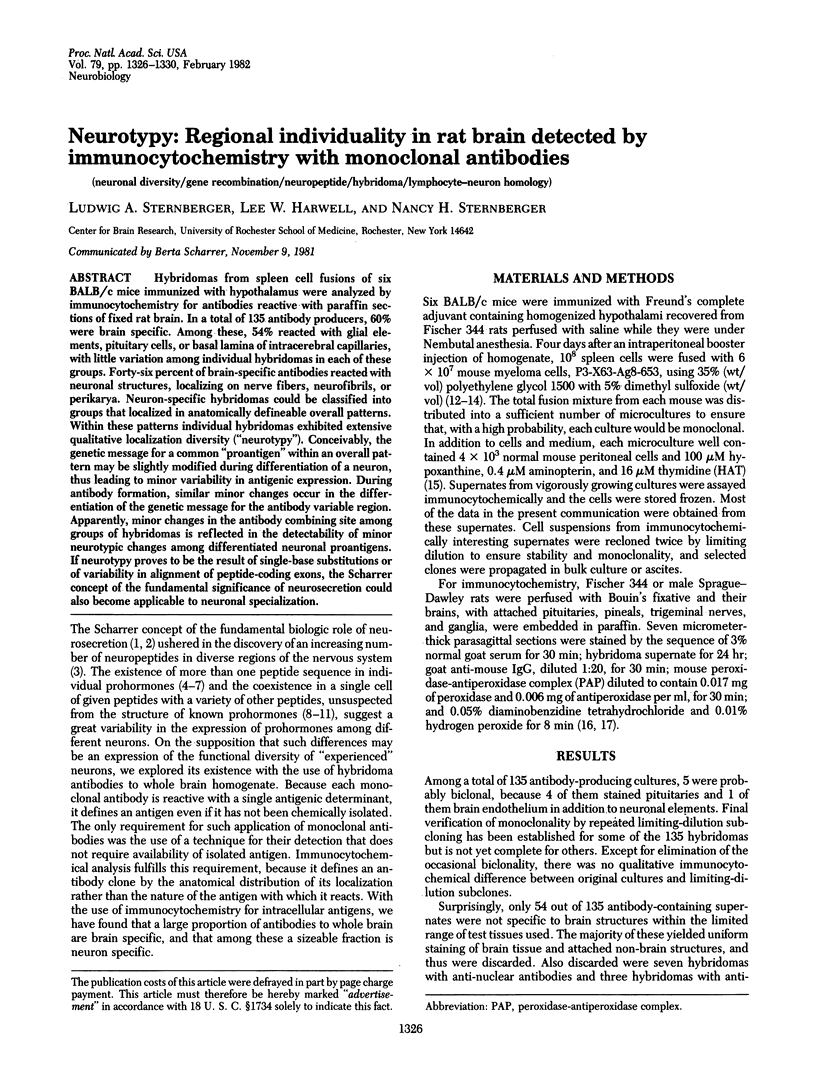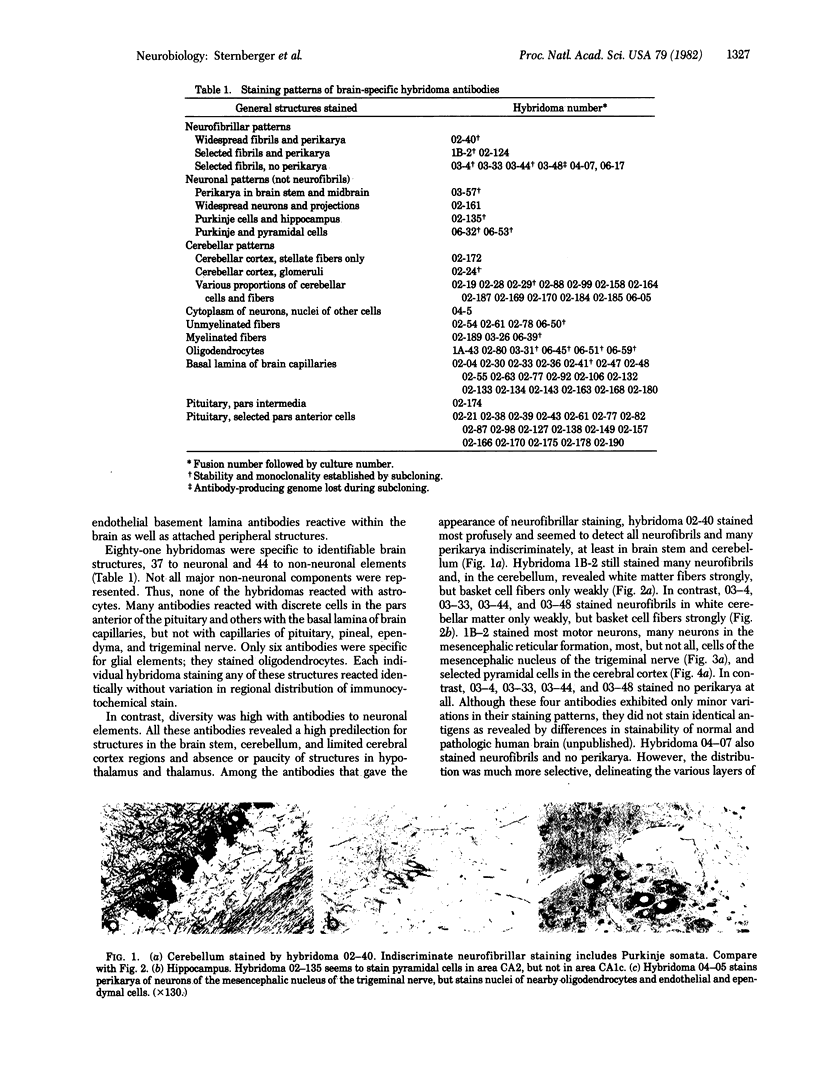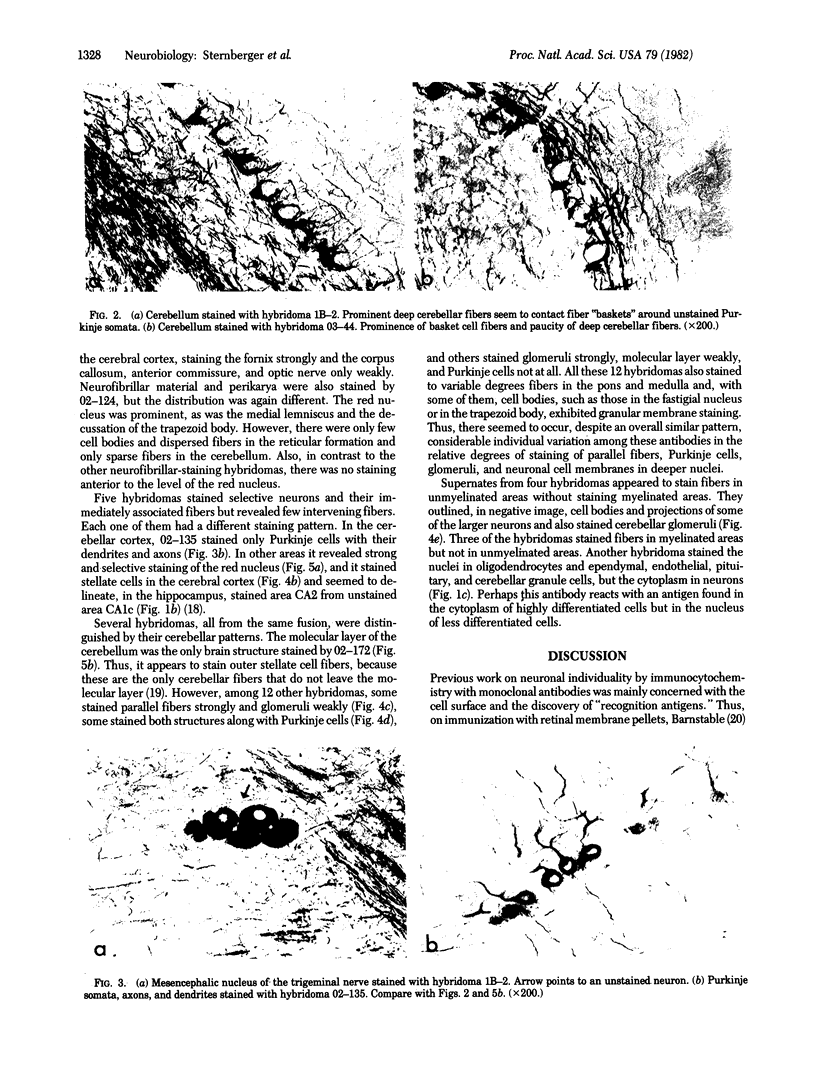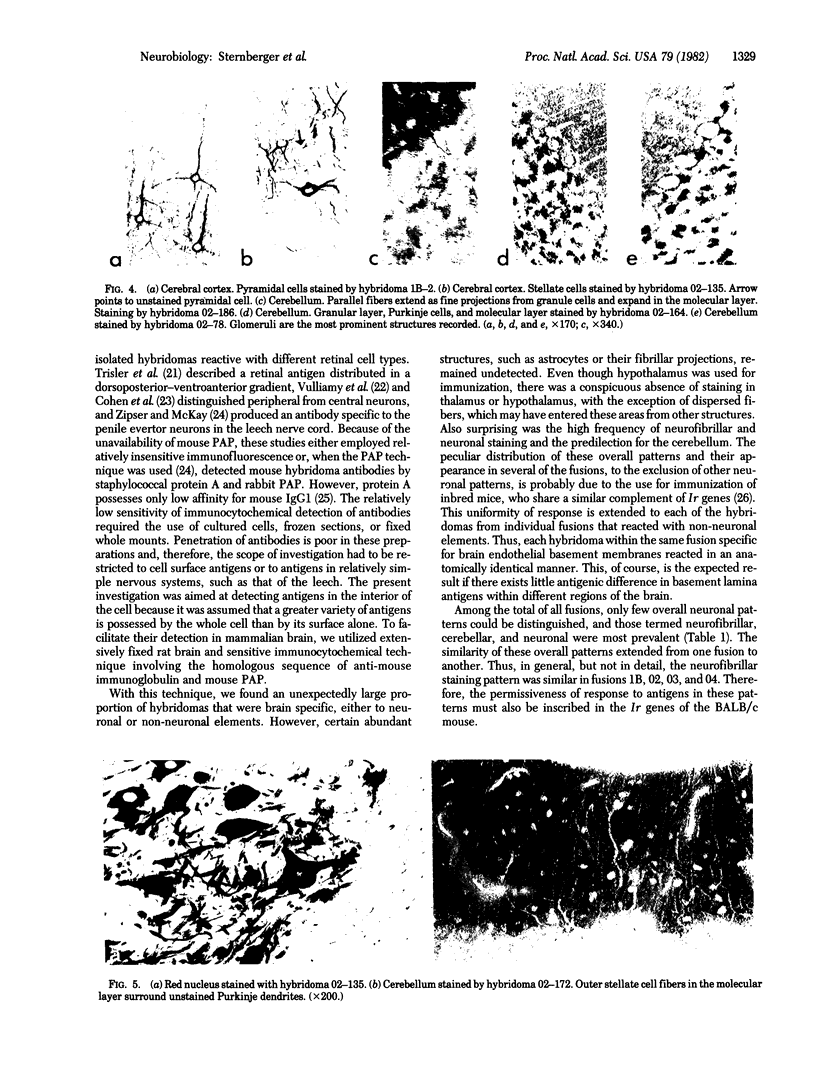Abstract
Hybridomas from spleen cell fusions of six BALB/c mice immunized with hypothalamus were analyzed by immunocytochemistry for antibodies reactive with paraffin sections of fixed rat brain. In a total of 135 antibody producers, 60% were brain specific. Among these, 54% reacted with glial elements, pituitary cells, or basal lamina of intracerebral capillaries, with little variation among individual hybridomas in each of these groups. Forty-six percent of brain-specific antibodies reacted with neuronal structures, localizing on nerve fibers, neurofibrils, or perikarya. Neuron-specific hybridomas could be classified into groups that localized in anatomically defineable overall patterns. Within these patterns individual hybridomas exhibited extensive qualitative localization diversity ("neurotypy"). Conceivably, the genetic message for a common "proantigen" within an overall pattern may be slightly modified during differentiation of a neuron, thus leading to minor variability in antigenic expression. During antibody formation, similar minor changes occur in the differentiation of the genetic message for the antibody variable region. Apparently, minor changes in the antibody combining site among groups of hybridomas is reflected in the detectability of minor neurotypic changes among differentiated neuronal proantigens. If neurotypy proves to be the result of single-base substitutions or of variability in alignment of peptide-coding exons, the Scharrer concept of the fundamental significance of neurosecretion could also become applicable to neuronal specialization.
Full text
PDF




Images in this article
Selected References
These references are in PubMed. This may not be the complete list of references from this article.
- Barnstable C. J. Monoclonal antibodies which recognize different cell types in the rat retina. Nature. 1980 Jul 17;286(5770):231–235. doi: 10.1038/286231a0. [DOI] [PubMed] [Google Scholar]
- Beauvillain J. C., Tramu G., Dubois M. P. Ultrastructural immunocytochemical evidence of the presence of a peptide related to ACTH in granules of LHRH nerve terminals in the median eminence of the guinea pig. Cell Tissue Res. 1981;218(1):1–6. doi: 10.1007/BF00210085. [DOI] [PubMed] [Google Scholar]
- Chalon M. P., Milne R. W., Vaerman J. P. Interactions between mouse immunoglobulins and staphylococcal protein A. Scand J Immunol. 1979;9(4):359–364. doi: 10.1111/j.1365-3083.1979.tb03174.x. [DOI] [PubMed] [Google Scholar]
- Cohen J., Selvendran S. Y. A neuronal cell-surface antigen is found in the CNS but not in peripheral neurones. Nature. 1981 Jun 4;291(5814):421–423. doi: 10.1038/291421a0. [DOI] [PubMed] [Google Scholar]
- Gearhart P. J., Johnson N. D., Douglas R., Hood L. IgG antibodies to phosphorylcholine exhibit more diversity than their IgM counterparts. Nature. 1981 May 7;291(5810):29–34. doi: 10.1038/291029a0. [DOI] [PubMed] [Google Scholar]
- Hamann A., Arndt R., Klein P., Thiele H. G. Isolation and characterization of the thymus-brain antigen (analogous to thy-1 antigen) from human brain. Biochem J. 1980 May 1;187(2):403–412. doi: 10.1042/bj1870403. [DOI] [PMC free article] [PubMed] [Google Scholar]
- Honjo T., Kataoka T. Organization of immunoglobulin heavy chain genes and allelic deletion model. Proc Natl Acad Sci U S A. 1978 May;75(5):2140–2144. doi: 10.1073/pnas.75.5.2140. [DOI] [PMC free article] [PubMed] [Google Scholar]
- Hökfelt T., Johansson O., Ljungdahl A., Lundberg J. M., Schultzberg M. Peptidergic neurones. Nature. 1980 Apr 10;284(5756):515–521. doi: 10.1038/284515a0. [DOI] [PubMed] [Google Scholar]
- Joseph S. A., Sternberger L. A. The unlabeled antibody method. Contrasting color staining of beta-lipotropin and ACTH-associated hypothalamic peptides without antibody removal. J Histochem Cytochem. 1979 Nov;27(11):1430–1437. doi: 10.1177/27.11.92499. [DOI] [PubMed] [Google Scholar]
- Kearney J. F., Radbruch A., Liesegang B., Rajewsky K. A new mouse myeloma cell line that has lost immunoglobulin expression but permits the construction of antibody-secreting hybrid cell lines. J Immunol. 1979 Oct;123(4):1548–1550. [PubMed] [Google Scholar]
- Krieger D. T., Liotta A. S. Pituitary hormones in brain: where, how, and why? Science. 1979 Jul 27;205(4404):366–372. doi: 10.1126/science.221983. [DOI] [PubMed] [Google Scholar]
- Köhler G., Milstein C. Derivation of specific antibody-producing tissue culture and tumor lines by cell fusion. Eur J Immunol. 1976 Jul;6(7):511–519. doi: 10.1002/eji.1830060713. [DOI] [PubMed] [Google Scholar]
- LITTLEFIELD J. W. SELECTION OF HYBRIDS FROM MATINGS OF FIBROBLASTS IN VITRO AND THEIR PRESUMED RECOMBINANTS. Science. 1964 Aug 14;145(3633):709–710. doi: 10.1126/science.145.3633.709. [DOI] [PubMed] [Google Scholar]
- Mains R. E., Eipper B. A., Ling N. Common precursor to corticotropins and endorphins. Proc Natl Acad Sci U S A. 1977 Jul;74(7):3014–3018. doi: 10.1073/pnas.74.7.3014. [DOI] [PMC free article] [PubMed] [Google Scholar]
- Martin R., Voigt K. H. Enkephalins co-exist with oxytocin and vasopressin in nerve terminals of rat neurohypophysis. Nature. 1981 Feb 5;289(5797):502–504. doi: 10.1038/289502a0. [DOI] [PubMed] [Google Scholar]
- Nakanishi S., Inoue A., Kita T., Nakamura M., Chang A. C., Cohen S. N., Numa S. Nucleotide sequence of cloned cDNA for bovine corticotropin-beta-lipotropin precursor. Nature. 1979 Mar 29;278(5703):423–427. doi: 10.1038/278423a0. [DOI] [PubMed] [Google Scholar]
- Scharrer B. Peptidergic neurons: facts and trends. Gen Comp Endocrinol. 1978 Jan;34(1):50–62. doi: 10.1016/0016-6480(78)90243-5. [DOI] [PubMed] [Google Scholar]
- Selsing E., Storb U. Somatic mutation of immunoglobulin light-chain variable-region genes. Cell. 1981 Jul;25(1):47–58. doi: 10.1016/0092-8674(81)90230-0. [DOI] [PubMed] [Google Scholar]
- Sternberger L. A., Greenwald J. L., Hock D., Elger K., Forssmann W. G. A new hypothalamic substance, and not luteinizing hormone-releasing hormone, is detected immunocytochemically by antibody to luteinizing hormone-releasing hormone. Proc Natl Acad Sci U S A. 1981 Aug;78(8):5216–5220. doi: 10.1073/pnas.78.8.5216. [DOI] [PMC free article] [PubMed] [Google Scholar]
- Sternberger L. A., Hardy P. H., Jr, Cuculis J. J., Meyer H. G. The unlabeled antibody enzyme method of immunohistochemistry: preparation and properties of soluble antigen-antibody complex (horseradish peroxidase-antihorseradish peroxidase) and its use in identification of spirochetes. J Histochem Cytochem. 1970 May;18(5):315–333. doi: 10.1177/18.5.315. [DOI] [PubMed] [Google Scholar]
- Trisler G. D., Schneider M. D., Nirenberg M. A topographic gradient of molecules in retina can be used to identify neuron position. Proc Natl Acad Sci U S A. 1981 Apr;78(4):2145–2149. doi: 10.1073/pnas.78.4.2145. [DOI] [PMC free article] [PubMed] [Google Scholar]
- Vulliamy T., Rattray S., Mirsky R. Cell-surface antigen distinguishes sensory and autonomic peripheral neurones from central neurones. Nature. 1981 Jun 4;291(5814):418–420. doi: 10.1038/291418a0. [DOI] [PubMed] [Google Scholar]
- Zipser B., McKay R. Monoclonal antibodies distinguish identifiable neurones in the leech. Nature. 1981 Feb 12;289(5798):549–554. doi: 10.1038/289549a0. [DOI] [PubMed] [Google Scholar]
- de StGroth S. F., Scheidegger D. Production of monoclonal antibodies: strategy and tactics. J Immunol Methods. 1980;35(1-2):1–21. doi: 10.1016/0022-1759(80)90146-5. [DOI] [PubMed] [Google Scholar]







